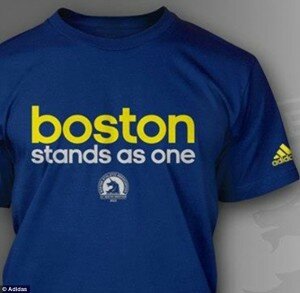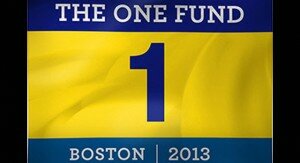September 11th…Hurricane Sandy…and now, Boston.
Each new tragedy raises expectations that corporations will do something to aid the victims. “Something,” however, has gotten ever more complex. After all, how do you support those affected without looking like you are cashing in on tragedy? And, in the case of Boston, who are you raising money for? Unlike Hurricane Sandy, for instance, where the Red Cross was an obvious recipient, this was an event where individuals were affected within the context of their daily lives. Their homes weren’t destroyed; their bodies were.
For Adidas, one of the sponsors of the Boston Marathon, doing something meant creating a t-shirt for which the proceeds would go to the One Fund Boston (see below). Ever the smart marketers, they had the shirt out almost immediately, they priced the shirts at $26.20 reflecting the 26.2 miles of the marathon, and the company logo was prominently displayed on the sleeve as you can readily see in the picture above. With people not knowing how or where to donate money, Adidas provided a focus and the product was successful beyond measure, selling out within a day according to Businessweek. Through the sale of this shirt, Adidas donated more than $1 million dollars, a company spokesperson told the Huffington Post.
Not to be a naysayer, but let’s ask some questions:
1) If the sales of the t-shirt are generating the donation and there is obviously consumer interest, why stop at $1 million when the money is raised from the shirts’ proceeds? (It is the proceeds from the sale and not the entire purchase price that contributes to the donation so this is not directly coming out of the company’s pocket. Note: Initially the website said “proceeds;” it now says “profits.” I suspect because the original term was deceptive. Note too that while the shirt pictured above is no longer offered, Adidas is selling a simple grey t-shirt as a pre-order. There is no mention of a monetary cap, but there most likely is one given that this is standard cause marketing practice), and
2) Why create the t-shirt and not simply give a donation? With a market cap of $21 billion and more than $2 billion cash on hand, it’s not like Adidas couldn’t give the money themselves and take the accompanying tax writeoff.
The answer, in part, has to do with why any company engages in a cause marketing campaign: it generates goodwill, it provides significant and overwhelmingly positive PR and, in this case, for as long as those t-shirts last, the purchased item acts to promote Adidas and connect the company in consumers’ minds as a corporation that cares. A donation is a one-time event with no visual reminder; a t-shirt lasts forever.
Does that mean that Adidas was simply being opportunistic? Not necessarily…and this has more to do with consumers than corporations.
After a tragedy, there is a natural need for a talisman, something physical to hold on to in order to control your fear. A psychology theory, called terror management theory (TMT), hypothesizes that a function of culture is to help lessen anxiety around death. Awareness of one’s own morality is heightened after violent events like Boston, and people look for ways to manage their fear of the inevitable. Fear can be lessened by bolstering your self-esteem, which we often do by acquiring possessions, that is, we go shopping. Buying and wearing the t-shirt increases your positive sense of self (while assuaging your terror) because it reminds you that you have helped others while simultaneously demonstrating to others that you are a caring person. This is something that writing a check simply cannot do.
Alternatively, John Hancock–also a marathon sponsor–donated $1 million in cash, which became the “cornerstone donation” for the creation of the One Fund Boston, a charitable fund established by the city of Boston and the state of Massachusetts. I suspect this charity was created for a couple of key reasons: First, for those inside–and importantly outside–of Boston, the fund becomes a focal point for those wishing to help out. It’s about branding really. People are talking about “Boston” — the city, the marathon — it’s that one word that is on people’s minds. They aren’t thinking “Red Cross” or “United Way”; they are thinking “Boston” and the One Fund Boston provides a direction for people’s generous impulse. Second, in the wake of September 11th, a slew of charitable organizations appeared. Many were legitimate, but just as many were simply raising funds to cash in on the tragedy. (See The Huffington Post). Creating the One Fund Boston enabled the city to get ahead of those sorts of abuses.
So which is the better corporate response?
Both are acceptable within context. While I am not a big fan of attaching donations to the purchase of a product, we cannot negate people’s urge to have something physical to hang on to. I give Adidas kudos for clarifying their donation is based on profits; better would be if they said “$10 from the sale of this t-shirt goes to the One Fund Boston.” In terms of John Hancock and the One Fund Boston, the issue is going to be one of transparency: about how much money is raised (there is a tally of funds prominently displayed on the website) and about how the money is being distributed and to whom–that question remains unanswered.
Whether a tragedy or not, corporations have a responsibility to the communities within which they exist. We used to call that being a good corporate citizen. John Hancock and Adidas were both sponsors of the Boston Marathon. But these companies didn’t have a responsibility because they are sponsors, per se, but because they are members of the community affected by the tragic events: John Hancock as a member of the Boston community and Adidas as a member of the community of runners.
Since the bombing, many more companies have donated money with little publicity for themselves. This is right and good. Brand visibility needs to take a back seat in cases like these. Moreover, donations other than money need to be considered. There are often ways in which companies are in a unique position to help. For example, after Hurricane Sandy Home Depot not only donated $1 million including cleaning and building supplies, but they also organized volunteers and used their stores as drop-off sites for donations. Did this generate goodwill for the company? Yes. Was that the only reason the company did it? I don’t think so. I’m not that cynical.
Unlike other heartbreaking events, the need for immediate funding seems less acute. People will need assistance over the long term learning how to walk again and laugh again and maybe run again. We have all heard the heartwarming stories of people who were injured vowing to run the marathon. Maybe there is a company that can donate a lifetime supply of shoes, or the sports companies probably have trainers on staff and can provide access to those skills. In the end, it is up to the company to understand their expertise and see how they might use it in the service of good in a community that has been so sorely touched by evil.


